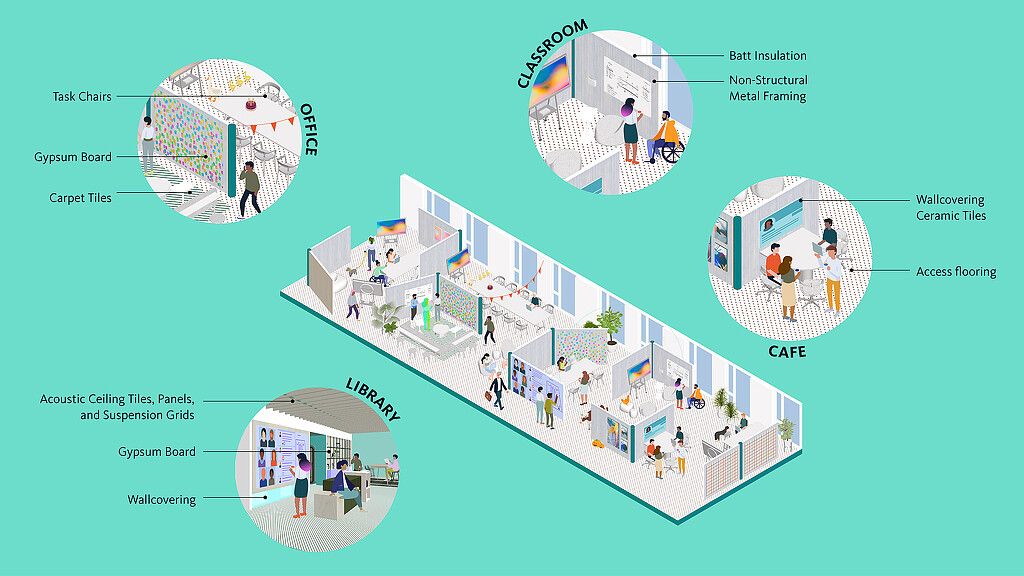Why Low-Carbon, Healthy Materials Are an Imperative for the Building Industry
March 13, 2025 | By Sarah Templin, David Briefel, and Jordan Cross
Editor’s Note: This blog is part of a series on the Gensler Product Sustainability (GPS) Standards™. As one of the first of its kind in the industry, GPS empowers architects, manufacturers, and clients to move towards more regenerative building materials. In recognition of this open-source tool, Fast Company recently named Gensler one of 2025's Most Innovative Companies. Click here to read more about our approach to this new initiative.
Your office space, your local hospital, your kid’s preschool, and your nearest airport all share several common building materials, from carpet and drywall to ceiling tiles and textiles. The composition of these products can significantly impact whether the environment is healthy or potentially harmful for you and those who manufactured them.
We created the Gensler Product Sustainability (GPS) Standards to prioritize and demand the production and selection of healthier, lower-carbon, more sustainable materials in the built environment. We believe this is one of our most significant opportunities for accelerating industrywide impact and creating a more circular and less carbon-intensive industry.
Building materials greatly affect the carbon footprint of a space. Instead of contributing to high levels of embodied carbon, they can be produced using methods that reduce carbon emissions, or even come from materials that sequester carbon. Additionally, at the end of their lifecycle, materials can either be discarded or incinerated, or they can be reclaimed and reintegrated into a circular economy.
When we scale up to the 1.25 billion square feet of building space that Gensler designs each year, the significant impact of these criteria on the industry, human health, and planetary health becomes profoundly evident.
Continually Improving Gensler’s Holistic Sustainability Criteria
By introducing the Gensler Product Sustainability Standards, we established sustainability performance criteria for the top 12 high-impact product categories, most used in our architecture and interior projects. The GPS Standards version 1.1 features clearly defined criteria that are pushing the industry to innovate and produce healthier products. However, designers regularly specify a wide range of other materials.
In October 2024, Gensler announced the next iteration of holistic, sustainability criteria for: wallcoverings, textiles, remaining gypsum, hollow metal doors and frames, insulated wall cladding, access flooring, broadloom carpet, and tile and asked for public comments. Final criteria was announced in January 2025 and the GPS team has begun vetting products for GPS compliance and training manufacturers and designers. Version 2 criteria will go live on Gensler projects on June 1, 2025.
The product categories we consider for criteria include those that are specified in large volumes, have a high carbon footprint, and are market-ready. Market readiness is defined as products that are supported by industry documentation such as: Health Product Declarations (HPDs), Environmental Product Declarations (EPDs), third-party certifications, and material ingredient disclosures.
- According to Flooring Daily, approximately 650 million square yards of commercial carpet are produced annually in the U.S.
- The 11th edition of Textile Exchange’s annual Materials Market Report indicates that global fiber production reached a record 124 million tons in 2023.
- Additionally, the Freedonia Group’s Global Countertops Report forecasts that global demand for engineered countertops will increase to 97 million square meters by 2028.
As one of the industry’s most influential design firms, Gensler has a tremendous opportunity to drive meaningful change.

The GPS criteria team is actively interviewing numerous manufacturers about the drafted criteria to ensure its attainability. Carey Gallagher, a sustainability specialist in Gensler’s New York office and the U.S. Criteria Lead and a primary author of the GPS v1 and v2 criteria, understands the importance of working with the industry to develop criteria that are both realistic and aspirational.
“To be adopted and effective, we need these criteria to be collaborative with manufacturers, and not prescriptive,” says Gallagher. Additionally, “none of the categories are mutually exclusive in terms of human health and environmental health. We’re thinking about how upstream and downstream impacts affect workers, installers, fabricators, and end users.”
So far, the impact has been significant across the U.S., Canada, the EU, and the U.K., as manufacturers, sub-contractors, and suppliers have adopted these criteria. So far, over 3,700 products have been vetted for GPS compliance, and more than 1,500 Gensler designers and 1,000 third-party manufacturers have been trained to meet these standards.
“We quickly found out that manufacturers were eager to listen, eager to share, and eager to have a partner in pushing the market towards a more sustainable future where their products and our projects could make a difference in reducing our impact on the environment,” said Benjamin Holsinger, Global Resilience Leader for Gensler’s Product Development practice.
Learn more about the effects of the introduction of GPS in How Gensler’s Product Sustainability Standards Are Making an Impact in the Industry.
What This Means for Our Clients and Designers
As clients strive to reduce their carbon footprint, we see this charge becoming a core part of their company’s values. According to JLL, between 2024 and 2030, three out of four new lease requirements among the top 100 office occupiers in major U.S. markets are expected to be tied to carbon commitments.
“People aren’t buying abstract sustainability anymore. You can’t say you’re sponsoring a rainforest if you aren’t even sorting your office trash” says Katie Mesia, a Firmwide Design Resilience Leader and Director of Sustainability for Gensler’s Southeast region. “Corporations are struggling with how to keep and demonstrate their environmental commitments in a way that is tangible and not abstract, and GPS offers a practical solution.”
In the post-COVID era, prioritizing employee health has become a new standard. Research shows that the built environment impacts the well-being of its occupants, and this alignment with employee health and environmental stewardship is increasingly seen as integral to corporate responsibility.
“GPS, in the best of ways, removes the choice of sustainability. Now I know the choices I make are inherently healthy for everyone,” says Dana Verbosh, Design Director in Gensler’s Baltimore office. “The market is getting better, so clients will have a sustainable project no matter what.”
As manufacturers increasingly disclose sustainability details in a more transparent manner, designers can no longer rely on a lack of information as an excuse. Gensler is committed to educating our team and empowering individuals to thoroughly investigate the impacts of everything we propose to our clients.
For media inquiries, email .



